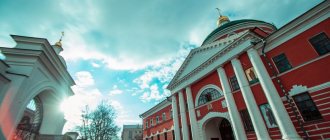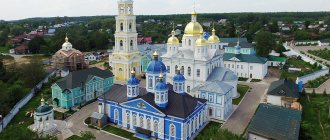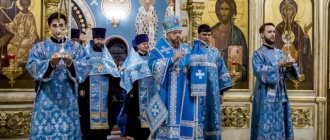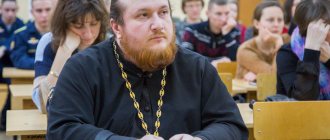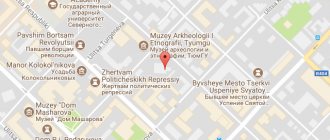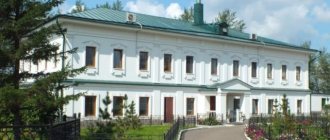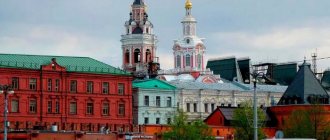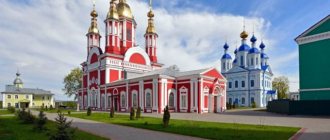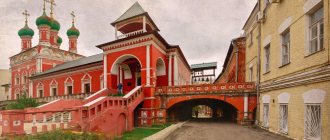| Kursk Znamensky Cathedral |
Kursk Znamensky Monastery
(Kursk diocese)
- Address: Russia, 305000, Kursk, st. Lunacharskogo, 4
- Tel.
- On the map: Yandex.Map, Google map
The foundation of the monastery is connected with the events of 1612, when the Polish-Cossack army besieged Kursk. The enemies who burst into the city carried out a massacre on its streets. The chronicler reported: “and there was a battle and shedding of blood here and there, and especially for us, Orthodox Christians and wives and children, great blood was shed at that time
.
However, the Kursk residents managed to gain a foothold in the small fort and repel the enemy from the fortress walls. When they were asked to open the gates, the besieged briefly answered that they would not surrender the city, but would rather die defending it. Enraged by the stubborn resistance, the enemies “became extremely furious and began to embitter this city with frequent strong attacks... they are arranging all sorts of tricks to capture the city
.
The besieged suffered from thirst, daily enemy attacks and a lack of gunpowder. During these days of difficult trials, the defenders of the city made a solemn vow that if God did not deliver them into the hands of enemies, they “in a small fort near the city at the end of the trade opposite the city bridge,
[on the site of the existing chapel]
they would erect the Church of the Most Pure Mother of God of Kursk
,” and in the miraculous image of the Sign, taken away by False Dmitry I to Moscow in 1604, will be placed on it. After four weeks of an unsuccessful siege, the thinned enemy army ingloriously retreated from the impregnable walls of the Kursk fortress.
Founding and flourishing of the monastery
Immediately after liberation, the Kurdish people began to fulfill their vow. First, a wooden temple was erected. And in 1613, Mikhail Feodorovich, who had just been elected to the kingdom, allowed “a monastery to be fenced and a courtyard to be built” next to the new church. By 1615, construction of the Nativity Monastery was completed. Another church was built in the name of the Monk Mikhail Malein with the Solovetsky miracle workers Zosima and Savvaty, a cell for the abbot and 14 cells for the brethren, the number of which soon reached 40 people.
In the same 1615, a representative delegation led by the cathedral deacon Polycarp was sent to Moscow, petitioning Mikhail Fedorovich for the return of his shrine to Kursk. The Kursk residents' request was met favorably. Upon returning home, the icon was kept for some time in the now defunct cathedral Church of the Resurrection, and then, in 1618, by personal order of the Tsar, it was transferred to the Nativity Monastery.
From that time on, the new monastery became the main monastery of the Kursk region. It includes the Trinity, Bozhedomsky and Pustynsky Bogoroditsky monasteries with all their grounds and lands. A special “Tarkhan” charter granted to the Kursk Monastery in 1629 contained a list of its rights and benefits and confirmed its privileges (for example, exemption from all state duties).
In 1631, almost all the monastery buildings burned down during a fire caused by a lightning strike, and the rest were destroyed by the soldiers of Prince Jeremiah Vishnevetsky in January 1634. During this raid, the Poles also burned the Trinity and Bozhedomsky monasteries. The monastery also suffered great damage during the Tatar raids of 1643, when “in the estates of its estates the peasants’ dwellings were completely destroyed, on the threshing floors in the stacks and in the fields the grain and hay were burned and poisoned,” 239 monastery peasants disappeared, not counting women and children.
In 1649, by decree of Alexei Mikhailovich, with money allocated from the royal treasury, as well as private donations, the construction of a stone cathedral church in the name of the Kursk Miraculous Icon of the Mother of God began in the monastery. After the construction of this temple, the monastery began to be called the Nativity of the Theotokos of Znamensky.
Since 1674, the abbot of the monastery, previously called abbot or builder, began to bear the title of archimandrite.
By 1680, with money donated by the army defending the Belgorod line and personally by the Kursk governor, Prince Grigory Grigoryevich Romodanovsky, new stone buildings were erected in the monastery: the Church of the Epiphany at the abbot’s chambers, the Peter and Paul Church at the holy gates, fraternal cells, outbuildings and a stone wall with towers around monastery
In 1752, the Znamenskaya Church was covered with plaster inside and out, one of its chapters was dismantled and five were erected in its place.
Secularization reform of 1764
In 1764, during the reform, the Znamensky Monastery was approved as a regular monastery and placed in the second class. Attributed to the Znamensky Monastery, the Root Nativity Hermitage received the status of an independent monastery. According to the staff, the Znamensky Monastery included an archimandrite, a treasurer, 6 hieromonks, 2 sextons, a mallow maker, a housekeeper (who is also a baker), a cup maker, a scribe and 16 ministers.
Erected by order of Alexei Mikhailovich, the stone church stood in the center of Kursk for almost a century and a half. But in November 1814, during a solemn prayer service, pieces of plaster began to fall on those praying from the dome of the temple. Conducted on behalf of Governor A.I. Nelidov's inspection of the building by Archbishop Neoktist and provincial architect Shmit revealed cracks in the vault of the refectory and on the walls of the cathedral that had formed as a result of subsidence of the foundation. Concern for the general condition of the building resulted in the desire to “build a new cathedral church instead of the old one of better architecture and more spacious than the present one.”
. In the summer of 1815, the project was already ready. Construction of the cathedral lasted 10 years. The first service in the new church took place on January 13, 1826. On this day, a coffin with the remains of Alexander I, who died in Taganrog, passed through Kursk, accompanied by a military escort. A memorial service was celebrated over the body of the late emperor in the hastily consecrated cathedral.
By decree of Emperor Nicholas I of September 28, 1832, the residence of the Kursk Archbishop, which had existed in Belgorod since 1667, was moved to the Kursk Znamensky Monastery, converted into a three-class bishop's house. The residence of the archbishop was located in a stone two-story building located near the cathedral. On the upper floor were the archbishop's chambers, and the lower floor was occupied by the monastery governor, the bishop's secretary and the office of the bishop.
In 1851, the Cross Church in the name of the Three Saints was added to the building.
In 1854, the Znamenskaya Monastery was returned to the title of a first class monastery. The number of monastics was increased and in 1891 there were 47 people serving in the monastery: a viceroy, a treasurer, a sacristan, a confessor, a dean, 4 regular hieromonks, 13 hierodeacons, 6 monks, 4 designated novices and 13 living on preliminary probation.
| Resurrection Church of the Kursk Znamensky Monastery |
In 1875, with donations from Kursk citizens, the Resurrection Church was built behind the cathedral building, and in 1876 it was consecrated.
Three altars were built in the temple: in the name of the Holy Resurrection of Christ, St. Theodosius of Pechersk and St. Joseph the Songwriter. In 1919, there were two altars in the Resurrection Church: the Resurrection of Christ and Theodosius of Pechersk. In addition to the churches, on the territory of the monastery there was a stone one-story building with 20 cells for monastics; a stone one-story outbuilding that housed a hospital, a fraternal meal and a kitchen, a stone outbuilding for singers of the bishop's choir and various outbuildings. Behind the monastery, across the road, there were two monastery courtyards with residential buildings, one of which housed a horse yard (a carriage house, a stable and two small outbuildings), and the other a shelter for male orphans. The monastery also owned the Znamenskaya bishop's dacha near Kursk, the bishop's dacha near Belgorod, land in the villages of Znamensky and Malyshevo in the Kursk district and the village of Novye Saviny in the Shchigrovsky district. In Streletskaya Sloboda (Kursk) the monastery also had estates in which some full-time ministers were settled.
Explosion in the Cathedral
On March 8, 1898, the miraculous image stored in the monastery became the object of a terrorist attack. At 1:15 a.m., a policeman standing on duty near the public places heard a deafening explosion inside the Znamensky Cathedral and saw a bright flash. One of the monks of the Znamensky Monastery recalled these moments this way:
“During a deep sleep, I heard a terrible hellish roar, from which my bed seemed to rock in the air... A second, another - and they were running along the corridor... Running out into the corridor, I met the monks and, together with them, hurried to the monastery courtyard... Barely We crossed the church threshold when a terrifying thick stench hit our faces. They brought in lanterns and began to light candles, but they were extinguished by the mass of thick and acrid smoke. Then they opened all the doors and created a draft in order to at least somewhat clear the air. When the church was illuminated, screams of horror burst from the chests of all those present. The entire vast cathedral was covered with various debris. There were plaster, pieces of wood, nails, pieces of moldings, and scraps of fabric lying everywhere.”
As a result of the explosion, the massive north door was literally pushed out, and the massive candlestick holding 150 candles was bent and distorted. The canopy where the Miraculous Image of the Mother of God was placed collapsed and fell apart into its component parts. Its walls and columns were moved out of place and severely burned, and the canopy in the form of a half-umbrella was pierced in several places by flying fragments. The steps leading to the icon were also damaged: the lower stone one severely damaged the cast-iron grate enclosing the elevation, and the upper wooden one flew through the entire temple and, hitting the opposite wall, located 17 steps from the canopy, bounced off it, damaging the large icon hanging on the wall, and fell in the middle of the church next to the bishop's pulpit. Fearing the worst, the Right Reverend Juvenaly and his brethren, with difficulty making their way through a pile of rubble, approached the place where the shrine was located and took out from the silver reliquary a completely unharmed image of the Mother of God “The Sign” of the Kursk Root. The face itself was not damaged, although the glass covering it was broken into small fragments, and the convex glass covering the crown of precious stones was heavily covered with soot.
Closing of the monastery
On April 12, 1918, the miraculous icon of the Sign and its copy, dressed in precious vestments decorated with gems and a golden tabernacle with the Holy Lamb, were stolen from the Znamensky Cathedral. Bishop Feofan (Gavrilov) immediately notified the local authorities about the loss of the shrine, but instead of investigating, employees of the Kursk Cheka stated that the real thieves were the monks themselves, who did this in order to sow dissatisfaction with the Soviet regime among the people. The bishop and all the brethren were put under house arrest, and a search was made in the monastery premises, which at times turned into real robbery. The next day the arrest was lifted and the robbed monks were ordered to sit quietly and not excite the people. The icons were discovered only a month later, in a well near the diocesan printing house. Two gold-embroidered icon cases were discovered in early October 1919, after the Whites occupied Kursk, in garbage heaps near the Cheka building. During the retreat of the Volunteer Army, the miraculous icon was taken from Kursk.
After the return of Soviet power, part of the premises of the Znamensky Monastery was occupied by soldiers of the 119th battalion of the internal security of the republic. And in November 1921, during an inspection of the Znamensky Monastery by the inspector of the Kursk Provincial Department of Administration Brusentsov, it turned out that all the residential buildings of the monastery were occupied by the 26th battalion of the internal security forces of the republic, and access for monastics to the courtyard was prohibited. The Church of the Resurrection was desecrated and robbed.
In October 1926, the Kursk Gubpolitprosvet appealed to the Presidium of the Kursk City Council with a petition “to secure and transfer to the Kursk Local History Museum the entire estate and buildings of the former monastery.” On November 2, 1926, the Presidium of the Kursk City Council granted this petition.
The museum actively began to develop the acquired space. In the summer of 1926, in the bishop's house, from where the last tenant, an employee of the headquarters of the Xth Rifle Corps, was evicted only in May, ten exhibition halls were opened for the industrial and economic department of the museum, two workrooms and a room for a library were equipped, the museum rented out four monastery wings for rent to various enterprises and institutions. The first wing housed a bakery and a candy factory for the Office of Unemployment Collectives at the Labor Exchange. The second wing was allocated for the office of the Provincial Archive Bureau and two apartments. The third wing was occupied by private apartments. The fourth is given to the administrative department for the registry office archive. The Resurrection Church was leased by the museum to the Archives Bureau for archival storage on the condition of “its maintenance and repair.”
The Znamensky Cathedral continued to be occupied by the religious community, which also paid the museum for 80 sq.m. “occupied for housing and the office of the diocesan administration.” The only building on the territory of the monastery that did not belong to the museum was the stone two-story fraternal building, used as a dormitory by the headquarters of the rifle corps. Four times the museum’s management petitioned the City Council to transfer the building to it, since “this building is in dire need. necessary for the development of the historical-revolutionary, industrial-economic and library departments of the museum, numbering 20,000 volumes.” The lawsuit ended in complete defeat for the museum workers. In the spring of 1928, the outbuilding was finally assigned to the military. But the last point in the struggle for the fraternal corps was set in August 1928, after the formation of the Central Black Earth Region, the headquarters of the corps was transferred to Voronezh, and the building it occupied was transferred to the local history museum.
In 1932, the Znamensky parish was liquidated and the Kursk City Council decided to build the 3rd sound cinema in the church. During the renovation process, the cathedral significantly changed its appearance, since in 1935 four small domes and both bell towers were demolished. On September 23, 1937, Kurskaya Pravda reported that
“Today, at 7 pm, the new cinema starts working... The main facade of the building is decorated with a colonnade. The beautiful entrance leads the viewer into the box office lobby. The theater foyer can accommodate about 800 people at a time. The foyer has upholstered and semi-upholstered furniture. In the lower foyer there is a dance hall. The auditorium of the new cinema has 700 seats.”
During the Great Patriotic War, the cinema building was badly damaged and burned out from the inside. The commission that examined it in October 1944 noted the absence of doors and window frames, severe destruction of the stairs, the completely removed roof of the dome, loose or crumbling plaster, and frescoes destroyed by fire and physical impact. But the building was not abandoned. At first, there was a warehouse for meat and dairy products, then a camp for prisoners of war, and in November 1945, all the buildings of the Znamensky Monastery were transferred to the low-voltage electrical equipment plant exported from Germany. The new owners set up an equipment warehouse in the central part of the former cathedral, a stamping shop in the refectory, and a plastics shop in the room on the south side. Another workshop was located in the basement of the Church of the Resurrection. Warehouses for hay and coal were built in two towers of the monastery fence. The bishop's house located next to the cathedral remained under the jurisdiction of the Kursk Regional Museum of Local Lore. The new owners, despite the requirements of the inspection for the protection of architectural monuments, did not pay due attention to the condition of the cathedral; and in 1948 they abandoned it altogether. The Kursk Regional Executive Committee handed over the dilapidated building to the Cinematography Department for the construction of a cinema in it.
In 1956, restored in accordance with the design of architects S.I. Fedorov and L.A. Litoshenko cinema "October" received its first spectators.
Revival of the monastery
In 1992, the building of the former Znamensky Cathedral was again transferred to the Church, but only in 1999 the Kursk diocese began work on rebuilding the temple. On April 23, 2000, golden domes and crosses were raised and strengthened onto the restored small domes of the Znamensky Cathedral.
In 1993, the exact copy of the original Kursk-Root Icon of the Mother of God “The Sign,” preserved during the years of persecution by pious Christians, was returned to the Znamensky Cathedral.
I remember the days of ancient Ps. 142.5
The history of the Znamensky Cathedral is closely connected with the fate of the Kursk region and our entire Fatherland. On the site of the current majestic temple there was once an ancient holy monastery. Its appearance dates back to the beginning of the 17th century. When in 1612, during the invasion of seventy thousand troops of Polish-Lithuanian invaders, the Kursk land was captured and devastated, the city fortress of Kursk, heroically defended under the leadership of governor Yuri Ignatievich Tatishchev, remained impregnable to the enemies. The townspeople attributed their salvation to the intercession of the Mother of God and then vowed to found a monastery in memory of this event. So, on the site of the current cathedral, a wooden church was originally erected, consecrated in honor of the Nativity of the Virgin Mary. Three years later, following a special petition from the residents of Kursk, Tsar Mikhail Feodorovich Romanov ordered the return of the most ancient shrine to them - the miraculous icon of the Mother of God “The Sign” of Kursk-Root, which until then had been in the royal chambers of Moscow. Already in the middle of the 17th century, by the royal decree of Alexei Mikhailovich, a stone cathedral church in the name of the Icon of the Mother of God “The Sign” with two chapels was founded on the site of a wooden one and by 1680 was built. A large fifty-pound bell was presented as a gift by Emperors John and Peter Alekseevich.
Its ringing for about three hundred years called the townspeople to prayer, and only in the second half of the 19th century was the cracked bell removed from the bell tower. Construction of the large Znamensky Cathedral began in 1815 and continued for ten years. This monumental structure was founded as a monument to the victory in the Patriotic War of 1812. With the blessing of Archbishop of Kursk and Belgorod Theoktist (Mochulsky), who ruled the diocese from 1787 to 1818, construction management was entrusted to Archimandrite Palladius (Belevtsev), who had until now been the rector of the Kursk Root Hermitage, a former artillery officer, originally from the Kursk nobles. The cathedral was built using donations from citizens and monastery income, and His Eminence Theoktist also made his contribution: having departed to the Lord in 1818, the bishop left in his will a very significant amount for the improvement of the temple. Governor Arkady Ivanovich Nelidov, as well as representatives of the Kursk nobility and merchants, took an active part in the creation of the new temple. Privy Councilor Grigory Apollonovich Khomutov, a great expert in architecture, showed ardent zeal in this matter on the part of the Muscovites; he assisted in the selection of craftsmen and workers, ensured cooperation with the best Moscow stone contractor, who personally observed the Kaluga masons erecting the temple walls. The main excavation work to construct a pit and a stone foundation, laid directly on solid ground, without any piles, was carried out in the summer and autumn of 1816.
After the death of Bishop Theoktist, the department was headed from 1818 to 1822 by Bishop Evgeniy (Kazantsev), and Father Palladius at the beginning of 1818 was appointed rector of the Znamensky Monastery instead of the deceased Archimandrite Iakinthos. They had the honor of meeting Emperor Alexander I, who visited the Kursk province in July 1820 and got acquainted with the progress of the construction of the cathedral. Its construction was completed by 1826, and on January 13 the cathedral was solemnly consecrated. However, the finishing work was still ongoing, and the consecration had to be rushed out of sad necessity: a funeral procession with the ashes of the deceased Emperor Alexander I was heading through Kursk from Taganrog. And so, three days after the consecration holiday, the hymns of a memorial service began to sound - the cathedral received the coffin with the body of the Blessed One Monarcha.
The style of classicism inherent in the architecture of the Znamensky Cathedral reflected the features of the Western European Renaissance, although alien in spirit to ancient Russian architecture, but quite in tune with the era of imperial Russia. The same aesthetics characterizes the decor of all interior elements. The traditional cross-domed design of the temple, cruciform in plan, has a greatly elongated western part. The central part, above which the light drum rises, is crowned with a grandiose spherical dome with a 20-meter diameter. The height of the under-dome space reaches 48 meters. The size of the cathedral is so significant that the residents of Kursk involuntarily compared it with the Moscow Cathedral of Christ the Savior. It should be noted that such a dome is hardly possible to find among the churches of Russia. And the idea of such an architectural solution belonged to Archimandrite Palladius. The brickwork on the outside was lined with “Myachkovo” stone, taken from the village of Myachkovo near Moscow; the thickness of the walls at the base reached 5.7 meters. The building, in addition to the main dome, is crowned with four small domes. All three facades from the north, south and west, as well as the altar apse, are decorated with columns with capitals of the Corinthian order. In 1826, two low bell towers were erected above the refectory part of the temple in the image of the Alexander Nevsky Lavra; on one of them, the northern one, facing Red Square, a striking clock was installed. In the history of the Znamensky Cathedral, the year 1866 is memorable, when three mighty bells were raised to the bell towers, the 1045-pound one, donated by the Belgorod merchant N. Chumichev, especially stood out. The main altar of the cathedral was dedicated to the Kursk-Root icon of the Most Holy Theotokos “The Sign”. In addition to it, there were southern and northern aisles, as well as others located in the choirs and in the refectory part of the temple. They were consecrated in honor of saints Mitrofan of Voronezh and Alexander Nevsky, Nicholas of Myra, Sergius of Radonezh, Tikhon of Zadonsk and Seraphim of Sarov. Above the refectory, a warm three-altar church was originally built in the name of the Presentation of the Lord, St. Nicholas and St. Anthony and Theodosius of Pechersk. But ten years later, in 1837, it was abolished.
The iconostasis of the main altar had a very unusual artistic solution - it was cast from cast iron. The work on its manufacture was so difficult that the iconostasis, ordered in 1824 at the Alexander Foundry in St. Petersburg, was installed only six years later. The large icon case for the temple icon “The Sign,” located on the left side of the iconostasis, also had a cast-iron canopy with gilding. The iconostasis, in addition, impressed contemporaries with its academic painting, which turned out to be an innovation for Kursk at that time: all the icons were painted on canvas by the St. Petersburg academician of painting Borghi. The walls of the cathedral, decorated in marble, were decorated with stucco images on religious themes; there were also paintings with biblical scenes painted on canvas by the icon painter Rukavitsyn. The dome was painted with frescoes. In the cathedral, among other shrines, two icons of the Kursk militia from the Crimean War of 1853–1856 were kept. With one of them – the “Sign” icon – Archbishop Iliodor of Kursk once blessed the Kursk army for battle.
A notable event in 1833 was the move to Kursk of the bishop's see, which had hitherto been located in Belgorod.
We must pay tribute to the memory of a remarkable personality - the builder of the Znamensky Cathedral, Archimandrite Palladius (Belevtsev). As his contemporaries testify, “the activities of this unforgettable man for the Kursk diocese were remarkable; “He put all his strength, all his energy, all his abilities into the construction of the temple and took every measure to ensure that the house of prayer being built was magnificent and majestic in architectural terms.” The future builder, who came from an ancient family of nobles, the Belevtsevs, was born in 1776 in Kursk, and received his education in the St. Petersburg Artillery Corps. Having taken monastic vows in the Root Hermitage, Father Palladius zealously served in the rank of hierodeacon, then hieromonk, and, finally, as rector. Having been transferred to the Znamensky Monastery, in 1816, in connection with the responsibilities assigned to him for the construction of the cathedral, he was elevated to the rank of archimandrite and was soon appointed rector of the monastery. In 1827, Father Palladium was nominated by Bishop Vladimir (Uzhinsky) to be awarded the diamond badge of the Order of St. Anna of the 2nd degree, and two years later received a new appointment - to St. Petersburg as the governor of the Alexander Nevsky Lavra. There he had to start building a new cathedral church.
It is impossible not to mention one event, as memorable in the history of the Kursk Cathedral as it was significant in the spiritual life of the ancient provincial city. During the Easter days of 1893, from May 3 to 4 (April 20–21, O.S.), the archpriest of the Kronstadt St. Andrew's Cathedral, Father John Sergiev, visited Kursk. The news of the upcoming visit had excited the whole city the day before; thousands of believers, led by Bishop Justin of Kursk and Belgorod and Vice-Governor E.K. Andreevsky, had already gathered to meet the shepherd, who was already revered as a saint. First of all, Father John went, accompanied by the bishop, to the Cathedral of the Sign, where he was presented with a copy of the icon of the Sign. That same evening he participated in the all-night service. In a crowded church, to the general consolation of those praying, Father John read the canon. This reading, oh, “astonishingly inspired... penetrated to the depths of the heart and acted on the soul not like an ordinary word, but as a living and, moreover, strong impression; himself o. John, it seemed, did not read, but experienced the content and convinced those praying.” At 9 o'clock in the morning, the Kronstadt pastor celebrated the Divine Liturgy in the Cathedral of the Sign, co-served by four hieromonks. The service made an amazing impression, and many of the worshipers cried throughout the service. After the liturgy, Father John visited the vice-governor and abbess of the Holy Trinity Monastery, Abbess Sophia (Stupina) in her monastery. Then he visited the Theological Seminary, visited some representatives of city society and educational institutions. In the evening of the same day he was right. John of Kronstadt left for Moscow.
Reigning persons have visited Kursk more than once, starting with Catherine II in 1787, and, of course, they visited the Znamensky Cathedral as one of the main city attractions. Emperor Alexander I came to Kursk three times: in 1805, 1817 and 1820. Alexander II was also here; Nicholas II visited Kursk twice: in 1902 and 1914. Grand ducals of the House of Romanov also visited Kursk. So, in December 1915, Grand Duchess Elizaveta Feodorovna arrived here. Staying at the Holy Trinity Convent, she already prayed in the Znamensky Cathedral on the day of her arrival.
The history of the Znamensky Cathedral is inseparable from the history of the great Russian shrine - the revered Kursk-Root Icon of the Sign is already in its eighth century, the miraculous discovery of which is dated by chronicle documents to the end of the 13th century. During those difficult times of the Tatar invasion, the city of Kursk and its devastated lands fell into complete desolation and became overgrown with forests. One of the pious residents of Rylsk, one day hunting in a thicket of forest, several miles north-west of Kursk on the banks of the Tuskari River, discovered a small icon lying at the roots of a tree, its appearance similar to the famous icon “The Sign”, which saved the inhabitants of Novgorod during the siege of it by the Suzdalians in 1169. The first miracle happened immediately - a full-flowing spring began to flow at the site of the find. This happened on September 21 (8 according to the Art. Art.), 1295 - on the day of the Feast of the Nativity of the Blessed Virgin Mary. Soon, a nationwide veneration of the newly found miraculous icon began, which received the name Kursk-Root, that is, found at the roots. During a new Tatar raid in 1383, the barbarians cut the shrine, which was kept in a chapel at the site of its discovery, into two parts, and its faithful keeper, a priest nicknamed Bogolyub, was taken captive. After some time, the priest, redeemed from captivity, found the broken parts of the holy image. When he folded both halves of the icon, a new miracle occurred - they instantly “grew together” in a supernatural way. For about two hundred years, the miraculously restored image of the “Sign” remained in the newly built chapel in the same place, until the fame of the miracles occurring from it reached the capital. In 1597, Tsar Theodore Ioannovich and Patriarch Job solemnly welcomed the shrine in Moscow. By royal order, a frame was made of cypress wood for the small icon, painted with images of the Lord of Hosts and the Old Testament prophets. It is in this composition that the icon has survived to this day. In the same year, by royal decree, the Kursk Root Hermitage was founded at the site where the icon was found, where the shrine was installed with appropriate triumph. During the Time of Troubles, the icon again ended up in Moscow, and only in 1615, condescending to the earnest petition of the Kursk citizens, Tsar Mikhail Feodorovich Romanov ordered it to be transferred again with great honor to his native monastery. The image is first decorated with royal generosity with a gold frame studded with pearls and precious stones. The request of the Kursk residents was preceded by the already mentioned event - the heroic defense of the city in 1612, in honor of which, according to the vow of the townspeople, a monastery with its cathedral Church of the Sign was erected in Kursk, which since 1618 has become an honorable place for storing the icon of the Sign. At the same time, a peculiar order of the famous annual religious processions with the transfer of the Znamenskaya Icon and the tradition of its alternating stay in the Root Hermitage and in the city cathedral arose.
The centuries-old all-Russian veneration of the miraculous Kursk icon has always aroused anger among people who are anti-God. It is impossible not to mention the alarming events at the turn of the twentieth century, which, however, revealed new evidence of the miraculous intercession of the Most Holy Theotokos. In March 1898, revolutionary-minded terrorists, trying to undermine popular faith in the miraculous power of the icon, committed a daring crime, deciding to destroy one of the most revered Russian shrines. Among the initiators of the plan are prominent Socialist Revolutionaries. The powerful explosive device was supposed to go off during a festive service; the Week of the Worship of the Cross was blasphemously chosen for this. However, due to the intervention of Divine Providence, the clock mechanism of the bomb malfunctioned, working with a significant delay, when there was no one left in the cathedral. A powerful explosion that tore apart the cast-iron canopy above the icon caused significant damage to the temple, even the wall cracked. But amid the general destruction, the icon remained completely unharmed; even the glass of the icon case was not damaged. The attempt on the shrine, contrary to the aspirations of the enemy, served to further glorify it. In memory of this miracle of saving the icon, a celebration was established on March 21.
Another blatant sacrilege was instigated by members of the Bolshevik Cheka. The latter circumstance was confirmed later, after the capture of Kursk by the troops of General Kutepov. As Archbishop Seraphim (Ivanov; 1897–1987), the author of the famous book “Hodegetria of the Russian Abroad,” recalls, in April 1918, the miraculous image of the “Sign” was stolen from the cathedral. Official appeals to the authorities for help, undertaken by the ruling bishop Feofan (Gavrilov), did not yield any results. The prayer offered for three weeks by the entire believer population of Kursk helped. The icon was miraculously discovered in the old Feodosievsky well, dug, according to legend, by the saint himself. Theodosius of Pechersk. And this happened on May 16 (3 according to the Old Style), on the day of remembrance of St. Feodosia. At the same time, instead of the stolen precious frame, a spare chasuble was put on the icon, quite simple, silver, covered with blue enamel - the same one that still adorns the holy image, which has become the main shrine of the Russian diaspora.
In November 1919, the Kursk-Root icon “The Sign”, together with the retreating units of the Volunteer Army, left the Kursk borders. She was taken away in their arms, saving her from desecration, by Archbishop of Kursk and Oboyansky Feofan (Gavrilov; at the see: 1917–1919), rector of the Root Hermitage Archimandrite Varnava, Hieromonk Hermogenes (Zolenko; +1958), who ended his life as an archimandrite in retirement in Jerusalem, hieromonks Aristarchus, Smaragd, Herman, Eleazar, Michael and Augustine, Archdeacon Ioannikios and four hierodeacons. And already in March 1920, on the steamer “St. Nicholas”, the Kursk miraculous icon, accompanied by Bishop Theophan and the monks who did not want to part with it, left the shores of Russia.
Time to gather the stones of Eccl. 3, 5
The Znamensky Cathedral suffered the sad fate of most of the Christian shrines of the Russian land, which were subjected to destruction and desecration in the post-revolutionary period. However, its fate, unlike thousands of other temples, is not so tragic - it was not completely destroyed. The cathedral was closed in 1924, the crosses were gradually removed from it, and the bell towers were demolished. They were going to demolish the main dome, but something stopped the atheists, and they limited themselves to the destruction of four small domes. In 1937, the building was converted into a cinema, called “October”. A cinema hall with 800 seats was located directly under the dome, film projectors were installed in the altar, and music foyers were installed on both floors of the refectory part of the temple.
During the Great Patriotic War, the cathedral shared the fate of the entire city - set on fire by the Germans during the retreat of 1943, the building was completely burned out from the inside, and the dome was partially destroyed. After seven years of neglect, a thorough reconstruction of the former cathedral into a two-screen cinema began in the fifties. External and internal reconstruction caused such significant damage to the architecture of the building that there was nothing left in its appearance reminiscent of its original liturgical purpose. Gradually, the area around the cathedral was thoughtlessly built up with industrial buildings, residential buildings were erected in such a way that they blocked the best vantage points that made it possible to appreciate the monumental architectural image of the temple. It seemed that the city had forever lost its once dominant architectural and spiritual structure - all the transformations that distorted its appearance and purpose seemed so irreversible.
Good changes became really noticeable in October 1992, when Archbishop Yuvenaly (Tarasov) of Kursk and Belgorod held his first service in a cramped, windowless corner on the third floor of the altar of the former cathedral, which took place to the sounds of the orchestra of the still operating Oktyabr cinema. The almost seventy-year period of desecration of the shrine was ending. After the transfer of the Cathedral of the Sign to the Russian Orthodox Church, regular services immediately began to take place here, which were conducted under the shadow of scaffolding, against the backdrop of ongoing restoration work. And their volume was truly enormous. It was necessary to restore four small drums with domes, rebuild the bell tower, cover the main dome, but first of all, internal reconstruction was required: the liquidation of structures from the fifties. To do this, it was necessary, in particular, to remove twelve powerful reinforced concrete columns that supported the internal false dome with which the light drum of the main dome was walled up, to dismantle the flights of stairs and ceilings between the two auditoriums, and to demolish all unnecessary partitions. In total, workers had to remove more than 600 tons of reinforced concrete structures from the cathedral.
Only in the autumn of 1999 the cathedral was freed from foreign structures, and at the same time the foundation pit for the bell tower was prepared. The builders began erecting small domes, and in the spring of next year crosses were already installed on them. In August 2000, the roof of the cathedral was covered with copper and construction of the bell tower began. Then two more significant events followed. On November 16, 2000, Metropolitan Yuvenaly consecrated the main altar of the Znamensky Cathedral, although the restoration work was still far from being completed. And on August 9, 2001, on the day of remembrance of the Great Martyr Panteleimon, a spire and cross were raised to the new cathedral bell tower.
It took more than a year and a half for the newly built bell tower to finally come to life. This happened on the Cross Worship Week of Great Lent, April 3, 2003: on this day, Bishop Juvenaly led the solemn ceremony of consecrating eleven new bells. The entire set was cast by special order in the Urals, the largest bell weighs 1 ton 380 kg. Upon completion of the consecration, the installers had to raise the bells to a 37-meter height. It should be noted that before the revolution, of the ten bells of the cathedral, the largest weighed 16 tons, and the ringing from the Znamenskaya bell tower could be heard even in the Korennaya Hermitage, which is located 30 kilometers from Kursk.
The general management of all restoration work was carried out by the chief architect of the city of Kursk, Valery Nikolaevich Mikhailov, and the interior design of the renovated Znamensky Cathedral was carried out by a team of artists of the Russian Academy of Arts from St. Petersburg, who had previously gained unique experience by painting the restored Cathedral of Christ the Savior in Moscow.
For a whole year, specialists, under the leadership of academician of painting Alexander Kirovich Bystrov, worked on developing sketches for the painting of the Kursk Cathedral. Another six months later, the first paintings on Gospel subjects and icons for the new iconostasis were created and delivered from St. Petersburg to Kursk. A large stained glass icon of the Mother of God “The Sign” of Kursk-Root was made for the altar, and stained glass windows depicting Saints Basil the Great, Gregory the Theologian, John Chrysostom and Nicholas the Wonderworker appeared in the high altar windows. St. Petersburg artists V.V. Perkhun, A.Yu. Sinitsa and P.M. Yakimchuk worked on them. Honored Artist of Russia Alexey Alekseevich Zhivaev created monumental images of eight Old Testament prophets: Jeremiah, Isaiah, Zechariah, Ezekiel, David, Solomon, Hosea and Elijah. Led by A. A. Zhivaev, the artists worked under the very dome, where the image of the Most Holy Theotokos sitting on the throne, surrounded by angels, and the images of St. Seraphim of Sarov, Sergius of Radonezh and thirty-six saints who shone in the Russian land appeared, among whom were the Royal Passion-Bearers Nicholas II and Alexandra with her children. Considerable work required the installation under the dome of a grandiose 2.5-ton gilded chandelier, fine casting and forge work, with twelve tiers of candles, made in the workshops of the Moscow Patriarchate production enterprise "Sofrino". In June 2004, during the days of preparation for the celebration of the 250th anniversary Since the birth of St. Seraphim of Sarov, the bell tower and façade of the cathedral were plastered and painted. And by July 5, the scaffolding inside the temple was removed and the transformed cathedral appeared in all its grandeur.
Behold now is the day of salvation 2 Cor. 6, 2
In 1993, the exact copy of the original Kursk-Root Icon of the Mother of God “The Sign,” preserved during the years of persecution by pious Christians, was returned to the Znamensky Cathedral. A copy was written in 1902 by the monks of the Znamensky Monastery and consecrated on the miraculous original. Nowadays, the ancient tradition of annual religious processions has been revived in Kursk - now, as in pre-revolutionary Russia, every spring, on the ninth Friday after Easter, the icon leaves the Cathedral of the Sign and marches to the Root Hermitage, reverently accompanied by thousands of believers of all ages and classes. In the fall, on the day of the Feast of the Nativity of the Blessed Virgin Mary, the icon returns to the cathedral with the same honors. Processions of the cross are always headed by the ruling bishop of the diocese; representatives of the city and regional authorities, led by the governor, join the solemn procession, as in the old days.
Among the significant milestones in the chronicle of the Cathedral of the Sign, it should be noted that the First Hierarch of the Russian Orthodox Church Outside of Russia, Metropolitan Laurus, visited it. What is especially noteworthy is the fact that this meeting on Kursk land immediately followed an epoch-making event in the history of the entire Russian Orthodox Church - the signing in Moscow of the “Act of Canonical Communion” of the two Churches. On May 21, 2008, Bishop Laurus and Bishop Michael of Geneva and Western Europe, accompanied by ROCOR clergy, arrived on a two-day visit to Kursk. In the evening, in the Znamensky Cathedral, distinguished guests took part in a joint all-night service. And on the morning of May 22, on the day of the celebration of the memory of St. Nicholas the Wonderworker, Metropolitan Laurus, Archbishop German of Kursk and Rylsk and Bishop Michael, co-served by the Kursk clergy, celebrated the Divine Liturgy. This memorable event will forever go down in the history of the Kursk diocese.
© 2009 Novikov N.M. – Author-compiler
What to see
The monastery was closed in 1930. and has been revived in our time. Because of this, the interior decoration of the churches was not preserved, but the restorers managed to restore the authentic appearance.
The pearl of the monastery is the Znamensky Cathedral. This magnificent palace-like temple was built in 1826 in the classical style. On top of the huge pistachio-colored volume stands a giant drum with an impressive silver dome. On the north side of the refectory there is a bell tower, which ends with a high gilded spire with a cross. The main relic of the cathedral is an exact copy of the icon of the miraculous Kursk Root Icon of the Mother of God “The Sign”.
To the left of the Znamensky Cathedral is the no less remarkable Church of the Resurrection, built in 1875. The temple was built in the spirit of eclecticism, and its main feature is the powerful walls made of red facing brick, painted with colored paints in the Byzantine style. In addition, the building has an impressively high ground floor: from the window sill to the foundation it is as much as 5 m.
The complex of the Znamensky Bogoroditsky Monastery also includes the Bishop's House. Today, the Kursk Regional Museum of Local Lore is open in a two-story stone building with bright green walls and an Empire-style colonnade and portico.
The monastery was once surrounded by a massive 17th-century fence, but today only one stone tower remains, facing the street. Sonina.
